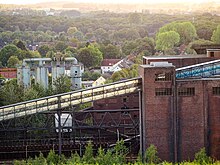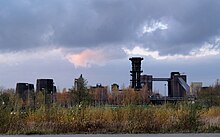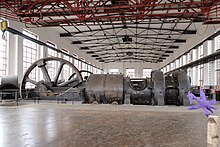Hansa coking plant
The Hansa coking plant is an architectural and industrial monument in Dortmund - Huckarde . It was built between 1927 and 1928 as a large-scale coking plant as a result of rationalization measures and replaced the run-down small coking plants in the Hansa , Westhausen and Germania collieries in the north-west of Dortmund.
Hansa is the anchor point of the European Route of Industrial Culture and, with the neighboring Deusenberg, one of the main locations of the International Garden Exhibition 2027 .
history


The first two coke oven batteries with 65 ovens each were built between 1927 and 1928. Batteries III and IV with 80 ovens each were added between 1940 and 1941. Only then was this coking plant operated as a central coking plant by Dortmunder Bergbau AG. The last expansion of the system was built in 1968 with the battery 0 (30 ovens). At peak times, up to 1,100 people worked in the coking plant.
Batteries I and II were so badly damaged in 1945 before the end of the war that both batteries were replaced by 1955, each with 62 ovens.
Until 1949, the Hansa coking plant obtained hard coal with large self-unloading wagons from the neighboring Hansa colliery , then via the newly built conveyor belt ( Hansaband ) and from the Westhausen and Adolf von Hansemann mines, initially using a cable car, then via a mine railway from Bodelschwingh via Nette to Hansa. After the Westhausen and Adolf von Hansemann collieries and the connecting railway were closed, the required coking coals were delivered by the Germania, Minister Stein , Gneisenau , Friedrich der Große , Pluto and Nordstern collieries, most recently from the Radbod , Haus Aden and Heinrich Robert collieries using large-capacity self-unloading vehicles . They reached the coking plant from the north via Hardenberghafen and Ellinghausen / Landabsatz through a newly created track connection to the freight railway of Hoesch-Stahl AG (track HHW 6141).
At full operating times, the central Hansa coking plant was producing up to 5,400 t of coke per day in its 314 ovens from around 7,000 t of coking coal mixture - mainly for Hüttenwerke Union , later Phoenix.
The raw gas produced during the production of coke (around 2,000,000 m³ per day) was first cleaned in the so-called carbon recycling plant and part of the coke oven gas was sent to the Union ironworks, later Phoenix. In return, the furnace gas from the smelting works was delivered to the coking plant as underfiring gas through the pipes that characterize the city (diameter approx. 2 m) .
The greater part of the coke oven gas was compressed in the horizontal, steam-powered, two-stage and double-acting gas piston compressors ( compressors ) to around 8.6 bar, cleaned using the high-pressure process and fed into the Ruhr gas network .
On December 15, 1992, the coking plant was finally shut down after two batteries had already ceased production in 1986. Their capacities were replaced by the new Kaiserstuhl coking plant , at that time the most modern coking plant in the world. The Mooskamp locomotive workshop in the north of the Hansa coking plant remained in operation until 2001, from where RAG Bahn- & Hafenbetriebe operated diesel locomotives in the eastern Ruhr area.
Since 1995, the Hansa coking plant has been owned by the Foundation for the Preservation of Industrial Monuments and History . Most parts of the plant have been listed as a historical monument since 1998 , and the Hansa coking plant is listed as a monument in the city of Dortmund's list of monuments and is part of the industrial heritage route . Since the shutdown, some rare animal and plant species have settled on the site.
Conversion
The entire facility can be viewed in the course of guided tours by former employees and trained, expert guides. Large parts of the facility remain closed to individual tourists due to the risk of accidents. Here the signposted “little way” is recommended, along with an audio tour via headphones.
Since 2001 the local transport museum Dortmund of the Westfälische Almetalbahn eV association has been located on the site of the locomotive workshop of the Hansa coking plant am Mooskamp . V., which offers sightseeing and charter trips with historical Dortmund trams over the old colliery tracks to the Hansa coking plant.
The restoration of the compressor hall with its five DEMAG gas piston compressors was completed in April 2005 and the hall was opened to the public by the then NRW Minister of Culture, Michael Vesper . Since then it has also been used for art exhibitions.
All plant parts and buildings of the Hansa coking plant that did not belong to the monument were demolished. After the coke dry cooling system (KTK) and the coal tower II were blown up, the 175,000 m³ large gas container and battery IV were also removed from the coking plant picture towards the end of 2005. The five pre-coolers, the three EGR filters, the two ammonia washers and the machine house with the gas suction devices were demolished in 2013. Two heritage-protected gas suction devices were moved into the remaining monument in advance. What remains is the extended edition of the central coking plant Hansa from 1928. Currently (July 2014) [out of date] sewer pipe rehabilitation and the implementation of a surface water concept are taking place.
All plant components and buildings belonging to the monument have been or are being renovated. After the complete restoration of the compressor hall with the compressors and the roof and compartment renovation of the buildings of the coal recycling plant, the four wooden natural draft cooling towers are currently (September 2011) [out of date] being renovated in accordance with the listed buildings.
On March 15, 2008, the largest climbing hall in North Rhine-Westphalia was opened on the site of the coking plant in the old "Bergwerk" turbo compressor building.
Since 2010, the former training workshop on the so-called white (“clean”) side of the coking plant has been used as an exhibition space. Hochhaus Hansa (high-rise on the Hansa site) is an art and exhibition project agreed for three years between the Foundation for Industrial Monument Preservation and History Culture and artlab21, Institute for Art Development.
Transport links
Take the U47 from Dortmund Hbf. In the direction of Westerfilde to the Parsevalstraße stop and then move next to the tracks in the direction of the Mailoh street, which gives you a first impression of the old cooling towers. Turn right in the direction of Mengeder Straße and from there you can already see the official entrance at Emscherallee 11.
Web links
- Description of this attraction and anchor point as part of the Route of Industrial Heritage
- Industrial monument foundation for the Hansa coking plant
- Hansa coking plant on the website of the city of Dortmund
- Dortmund Tourism to the Hansa coking plant
- Events Hansa Revier Huckarde at the Hansa coking plant
- Photos of the Hansa coking plant
- Photos of the Hansa coking plant by Paul Klimek
Individual evidence
- ↑ No. A 0871. List of monuments in Dortmund. (PDF) (No longer available online.) In: dortmund.de - Das Dortmunder Stadtportal. Monument Authority of the City of Dortmund, April 14, 2014, archived from the original on September 15, 2014 ; accessed on May 7, 2014 (size: 185 kB). Info: The archive link was inserted automatically and has not yet been checked. Please check the original and archive link according to the instructions and then remove this notice.
- ↑ - "Hochhaus Hansa" ( Memento of the original from March 4, 2016 in the Internet Archive ) Info: The archive link was automatically inserted and not yet checked. Please check the original and archive link according to the instructions and then remove this notice. Retrieved July 30, 2013
Coordinates: 51 ° 32 ′ 26.5 " N , 7 ° 24 ′ 44" E









